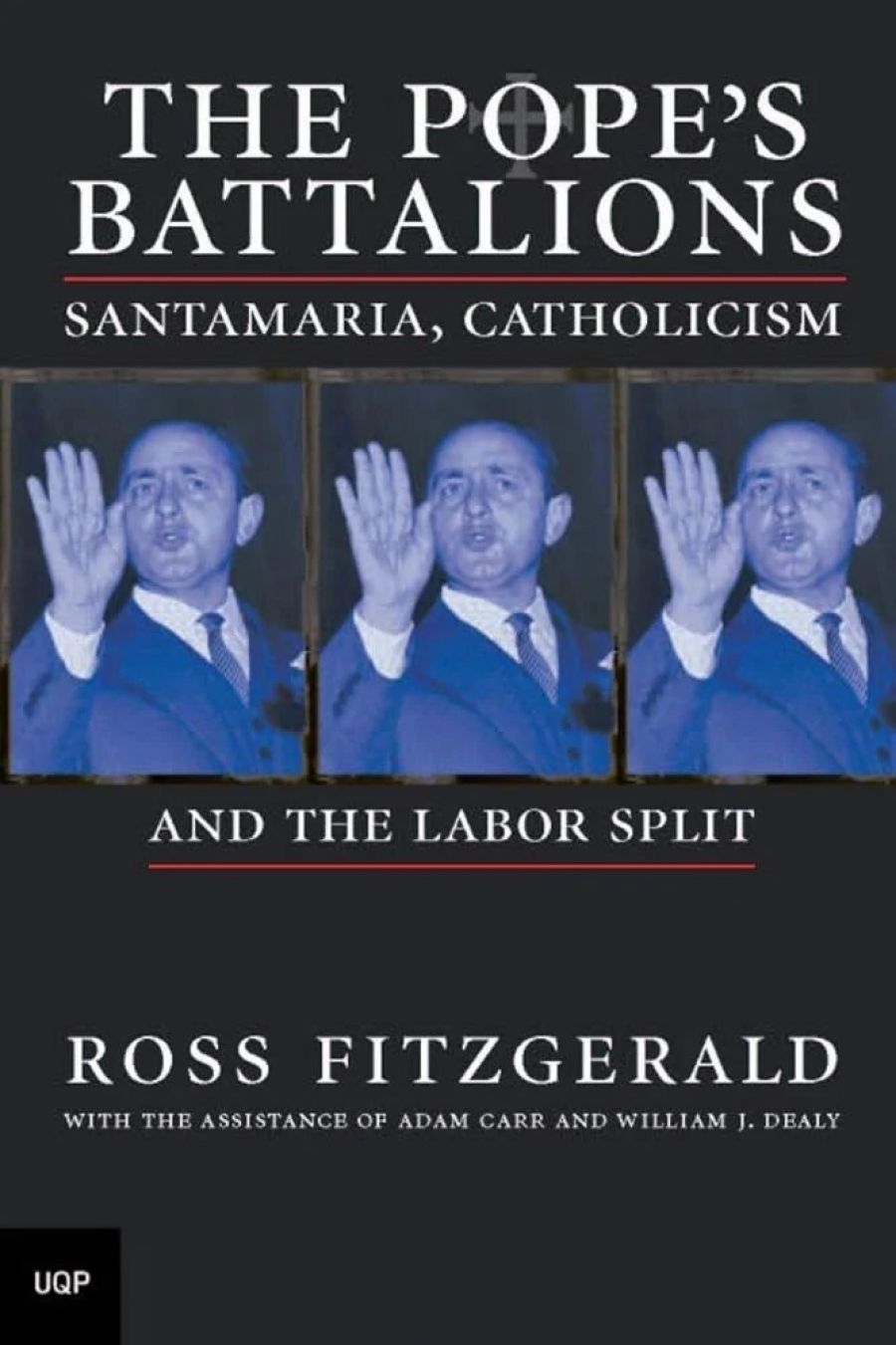
- Free Article: No
- Contents Category: Biography
- Review Article: Yes
- Article Title: The Great Pessimist
- Online Only: No
- Custom Highlight Text:
Ross Fitzgerald’s book is timely, for two reasons. Five years having passed since the death of B.A. Santamaria, an appropriate distance stands between the immediate obituaries and a better perspective on his impact on Australian politics. It is also nearly fifty years since the great Labor schism. A new generation of Australians has grown up for whom ‘The Split’ is not part of the political lexicon. The Pope’s Battalions reminds one of a time when this term required no explanation, just as ‘The Dismissal’ needs no explanation to Australians over a certain age.
- Book 1 Title: The Pope’s Battalions
- Book 1 Subtitle: Santamaria, Catholicism and The Labor Split
- Book 1 Biblio: UQP, $35 pb, 353pp
- Book 1 Cover Small (400 x 600):

- Book 1 Cover (800 x 1200):

Fitzgerald’s central thesis is that Santamaria never wavered in his basic views that unbridled capitalism or communism should be opposed relentlessly and that the Christian – preferably Catholic – way of life, based on strong family ties, was the basis of the perfect society. As Fitzgerald’s highly readable work unfolds, he sets Santamaria’s career against an Australian society that changed irreversibly in the 1960s and 1970s, meaning that any rapprochement between the ALP and what became the Democratic Labor Party (DLP) became impossible as the profiles of both parties’ supporters changed from those that had underpinned The Split.
One of Fitzgerald’s achievements in this book is to highlight the fact, obscured over many years, that Santamaria’s inseparable association with anti-communism, especially in the union movement, was not the whole story. During the Depression years and thereafter, Santamaria lined up on certain issues with those opposed to the evils created by rampant capitalism, including Jack Lang and E.G. Theodore. He continuously advocated policies aimed at alleviating the plight of the most vulnerable and entrenching the family as the strongest unit of society. As fear of communism from various sources was a major factor in political debate from the 1950s through to 1969 (which Fitzgerald rightly pinpoints as the time when Australian opinion turned against the Vietnam War), Santamaria’s ongoing concern with the purely market-driven economy became obscured. This aspect of Santamarian thought was never widely canvassed after the mid-1950s.
In discussing Santamaria’s social concerns, Fitzgerald points to some notable ironies. For example, it was the conservative Richard Nixon who undercut much anti-communist rhetoric by engaging with China and the USSR. It was the humanist Gough Whitlam who introduced needs-based school funding, a policy of the kind that Santamaria had long sought to bring relief to increasingly poor Catholic parochial schools. One of the few good words that Santamaria had for Whitlam lay in the former’s support for Medibank, the forerunner of Medicare. It was the agnostic Bob Hawke who achieved what the Industrial Groupers never did – the elimination of communism as a force within the union movement – while the working-class Catholic Paul Keating led Australia into deregulation, thereby unleashing the forces that Santamaria saw as having caused so much misery during earlier times.
As the focus on communism declines, we are presented with a sometimes pitiable and always pessimistic Santamaria, for whom the apocalypse was always nigh but for whom the target shifted as society changed. The 1960s saw the emergence of a middle-class, left-of-centre voting bloc, some of whose members came from working-class backgrounds, but who were well-educated, often based in the universities and predominantly secular in outlook or members of non-conformist churches. Simultaneously, the ‘permissive society’ emerged, supposedly confronting the supremacy of family life and traditional moral values, and prompting a DLP concentration on moral issues.
When the larger metropolitan universities became centres of dissent, Santamaria’s National Civic Council (NCC) shifted its focus from unions to campuses in an attempt to stop a new generation from drifting to the far left. These operations achieved some success, but the universal trend away from concentration on the evils of communism and the fact that the Catholic Church itself had not withstood the upsurge in social liberalism made the NCC’s efforts seem less relevant. The more general point is made that the DLP, for all the frustrations it caused Labor, had little influence on various governments. This was in large part due to the long and unrivalled dominance of Robert Menzies, together with the DLP’s subsequent loss of social and political relevance.
Towards the end of his book, Fitzgerald emphasises the extent to which the ‘Protestantisation’ of teachings within his own church most greatly saddened Santamaria. The death in 1963 of Daniel Mannix and all he stood for constituted a loss for Santamaria that was not alleviated until he established a close relationship with Archbishop Pell.
Notwithstanding its abundant detail, The Pope’s Battalions is easy to read. While making his points cogently, Fitzgerald flavours his work with interesting vignettes of events and people. We read of the reasons why William Deane briefly joined the DLP; the background of DLP Senator Jack Kane; and the close relationship between Santamaria and R.G. Casey. I came across only one factual error in the book, a reference to National Party leader John Anderson being a Catholic: he is an Anglican. The thirty pages of footnotes are encyclopaedic, often providing further biographical and historical information.
The assessment of Santamaria’s life in the final pages of the book is moving. The verdict is that, with the exception of his family, nothing that Santamaria loved unstintingly was the better for his efforts. For his admirers, this is tragic; for his enemies, the verdict might constitute belated justice. From either viewpoint, The Pope’s Battalions is highly recommended.


Comments powered by CComment